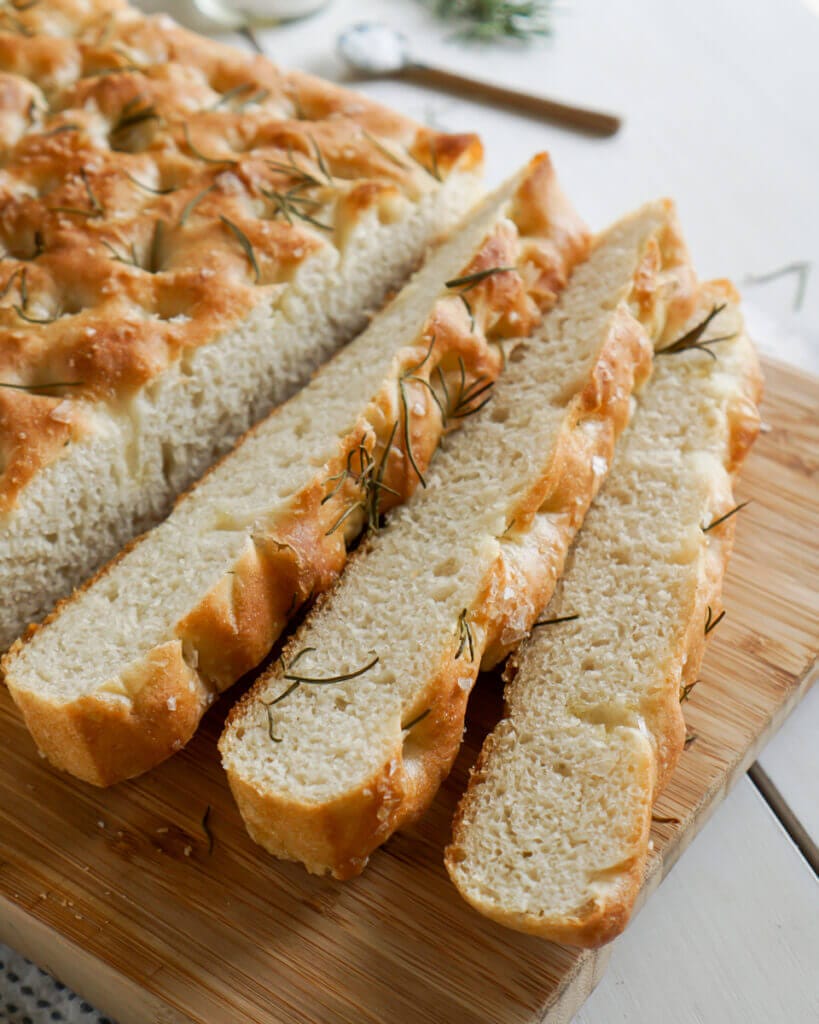
If you are new to working with yeast, focaccia bread is a great place to start. And if you are familiar with yeast dough you’ll love the ease of this homemade bread and how much fun it is to make. Typically focaccia bread is made without the kneading process and is left alone to do its own thing over a long period of time. But I wanted to create a recipe with less waiting time so a little kneading will do the trick.
This homemade focaccia bread is soft and chewy, with salty bits and fresh hints of rosemary. The bulk of the flavour comes from the olive oil as it sits and absorbs into the dough over the proofing stages (first rise, second rise) and as it bakes. The best part is pushing dimples into the dough. The oil sits and pools into each pocket, and while it bakes the bread is enriched with more flavour.
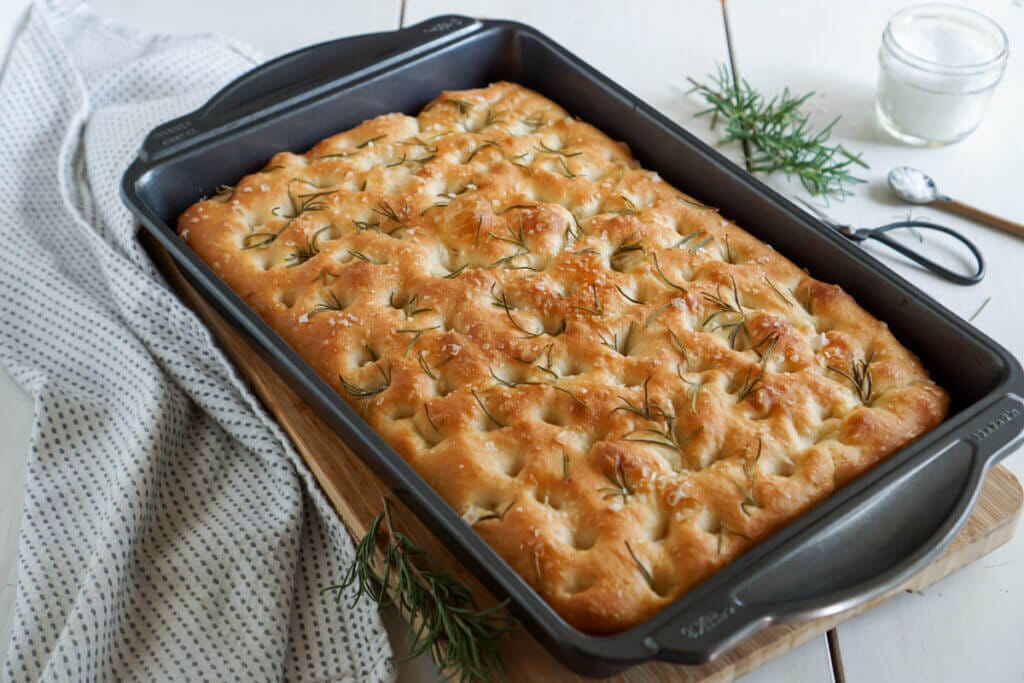
Ingredients
There are only a few, simple ingredients in this recipe so it’s key to have fresh and good quality ingredients. The most important is to have a good quality olive oil as that is where a lot of your flavour will come from (I like to use extra virgin olive oil ). When it comes to yeast you can find it at many stores but I buy mine at Bulk Barn Foods where I can purchase as little or as much as I like. I prefer to buy it loose and in bulk and store it in a dark jar in the fridge. This saves on packaging and the environment, so I’m a big fan!
- Active dry yeast
- Unbleached bread flour
- Fresh rosemary
- Olive oil
- Flaky sea salt & table salt
- Granulated sugar
- Butter for greasing
Focaccia Sizes & Variations
You can make focaccia in many different sizes and varieties. It’s a bread that you can play around with and add your favourite toppings to make it your own. Here are some options:
- Two 9″ pie plates, or two 9″ square pans (divide dough in half and follow the recipe as directed)
- For a thinner focaccia use a baking sheet.
- Fresh herbs
- Italian seasoning
- Roasted garlic
- Roasted vegetables
- Cherry tomatoes
- Caramelized onions, red onion
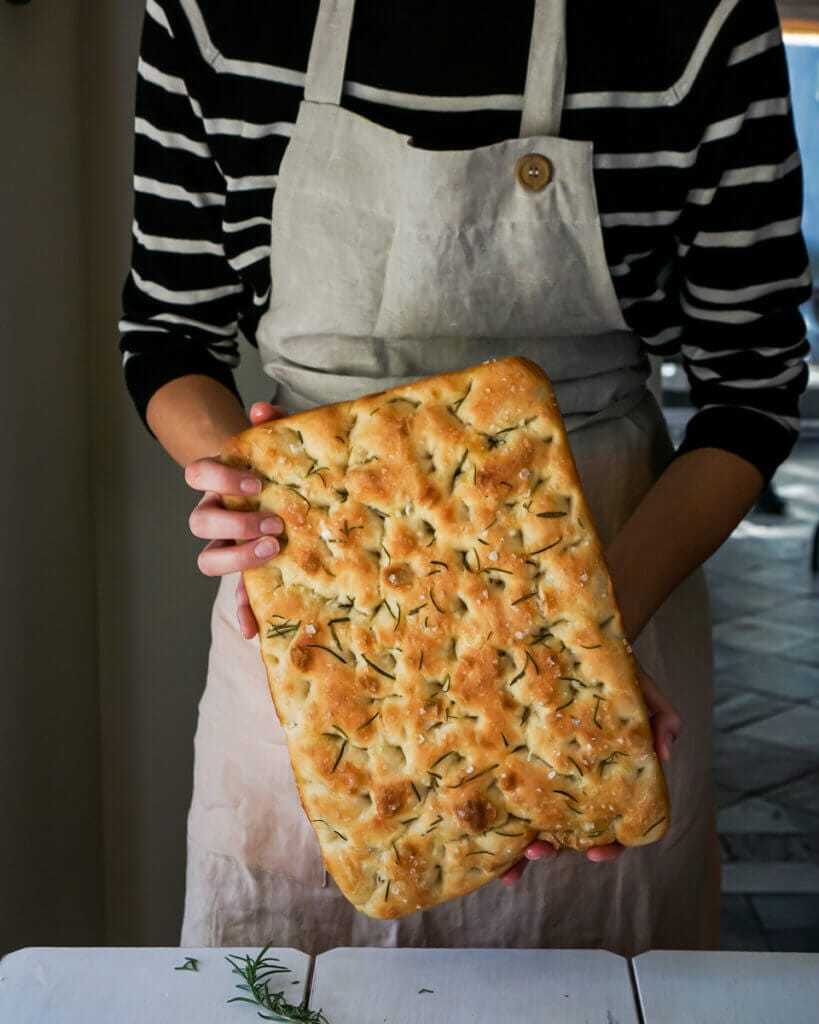
What goes with Rosemary Focaccia Bread?
Rosemary Focaccia bread makes a great side on an antipasto plate filled with olives, cheeses, meats, stuffed peppers and artichokes. You can also serve focaccia bread with balsamic vinegar as a side for pasta dishes and soups. It makes great sandwich bread!
Tips For the Best Focaccia Bread
- For best results use top quality olive oil (I like to use extra virgin olive oil ). The olive oil is where your flavour will come from, so it’s very important!
- This is a sticky dough and typically focaccia bread is left for a long time to proof on its own. This version comes together in less than 4 hours. Because it’s a sticky dough make sure you gently knead the dough with the palm of your hands. If you press the dough too hard it will stick to you.
- Be careful not to add too much flour. Again, being a sticky dough means you need to add flour to help you handle the dough, just use it sparingly as too much flour can cause dense dough.
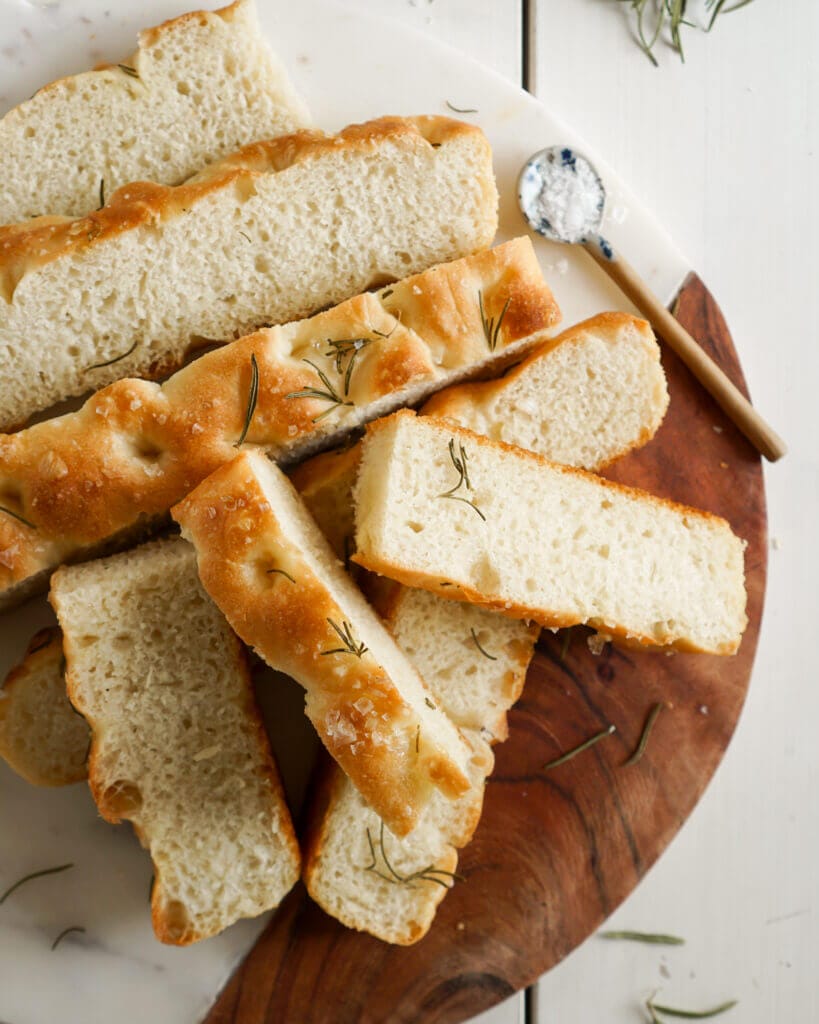
How to Make Focaccia Bread Ahead of Time
You can also prepare your bread the day ahead and bake it fresh the following day. Simply follow the instructions to step 6 and place your prepared dough into the fridge for up to 18 hours. Then the following day pull your dough out and let it rest at room temperature for 20-30 minutes and continue to step 7.
How to Make Rosemary Focaccia Bread
Step One: In a large bowl add warm water, yeast, and sugar together, let rest 8-10 minutes until the yeast mixture is frothy. When yeast is ready add 3 cups of the flour and using a fork bring the dough together until shaggy. Add another 1/2 cup of the flour and the salt. Mix to combine.
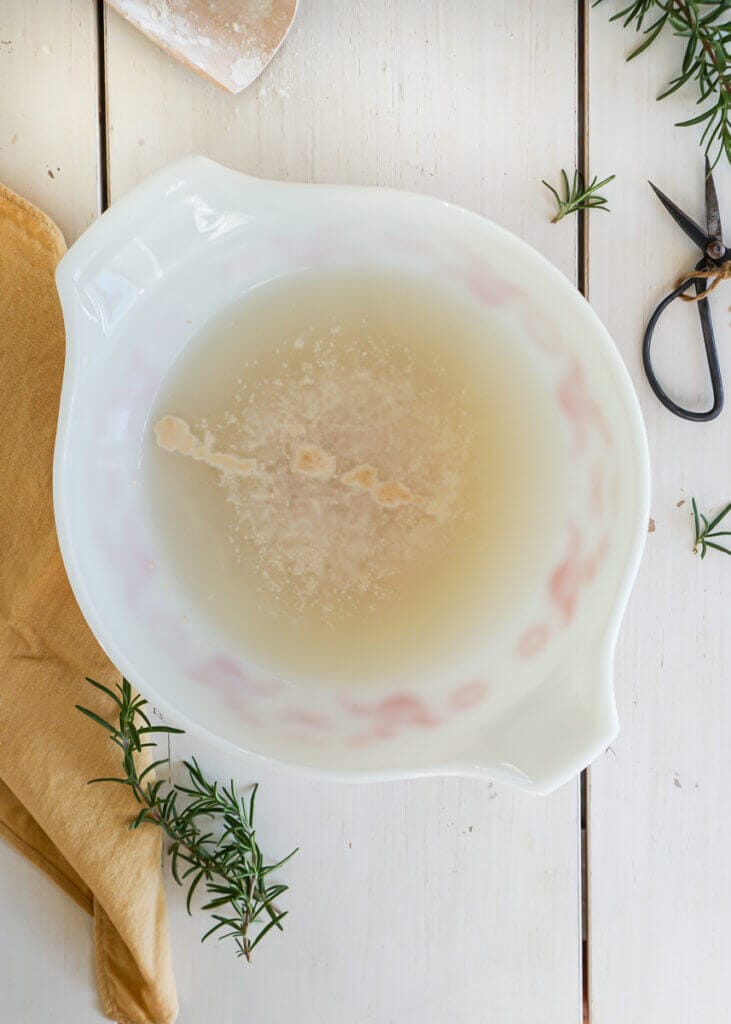

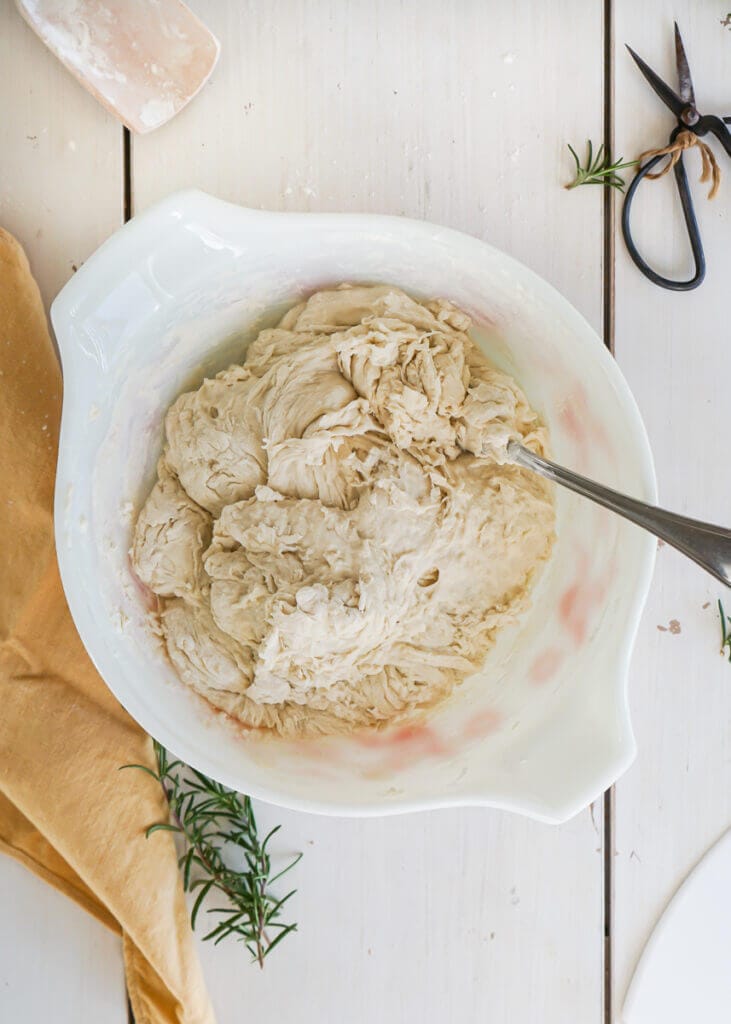
Step Two: Turn the dough out onto a floured work surface and knead the dough for approx. 6-8 minutes until smooth, and when poked with your finger will spring back. Roll focaccia dough into a ball. In a large clean bowl coat the bowl with oil, add the dough and pour 1 tablespoon of the oil all over the dough. Cover with plastic wrap, a damp tea towel, or a shower cap. Let dough rest in a warm draft free place until doubled in size, approx. 1-2 hours.
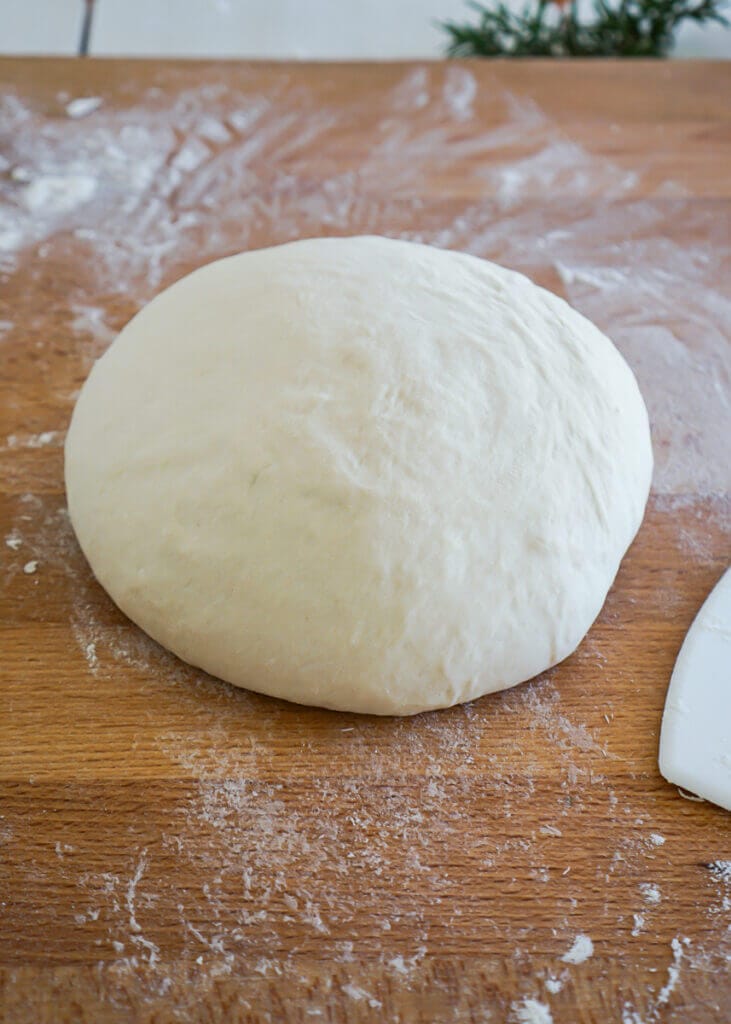
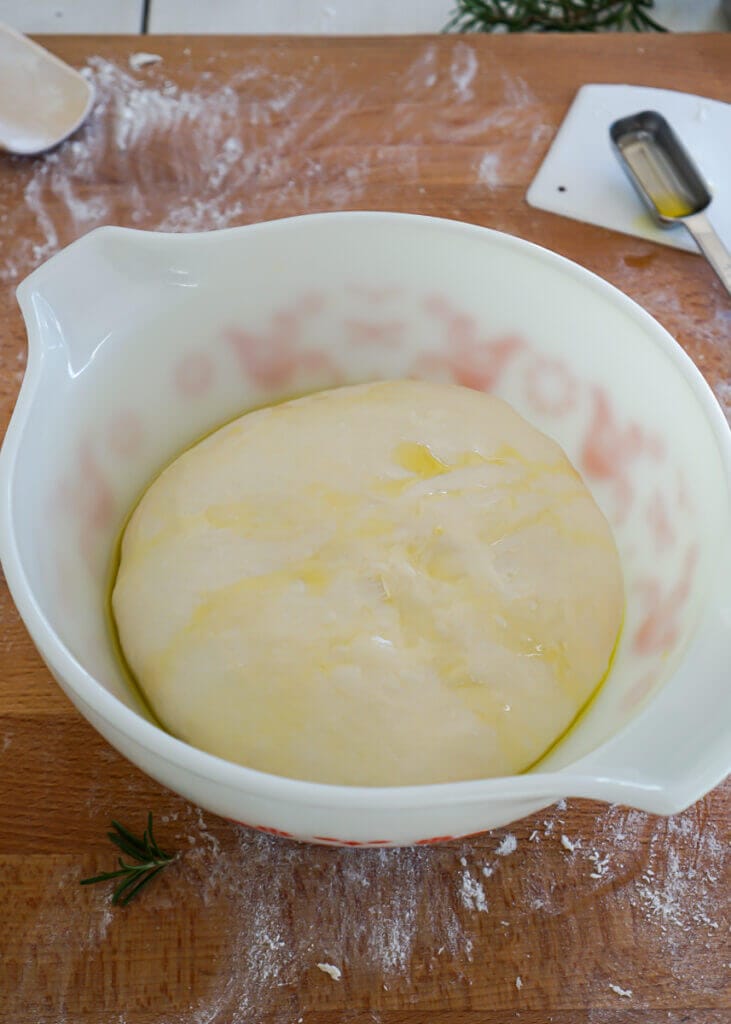
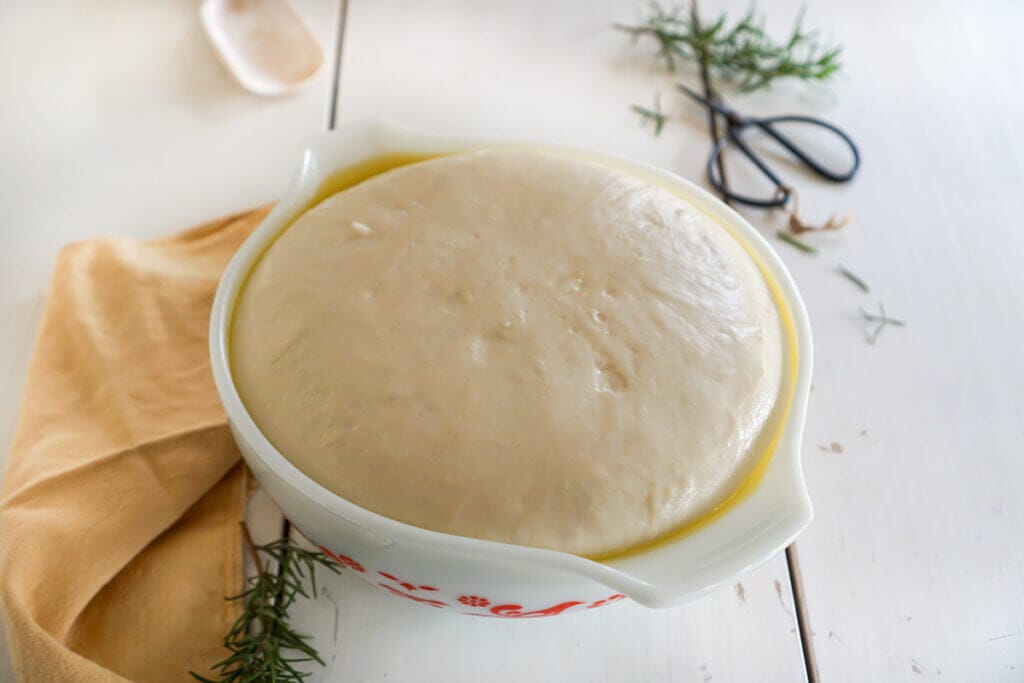
Step Three: Once the dough is doubled in size, punch dough down and place in the oiled pan. Stretch the dough out to fit the pan. Cover with plastic wrap and let rest in a warm place until doubled in size approx. 30-40 minutes. Once the dough is doubled in size, sprinkle rosemary all over the top of the dough and the remaining 1 tablespoon of olive oil. Using your fingers press them straight into the dough to create dimples throughout the dough, making sure to press all the way to the bottom of the pan. Sprinkle the top with flaky sea salt.
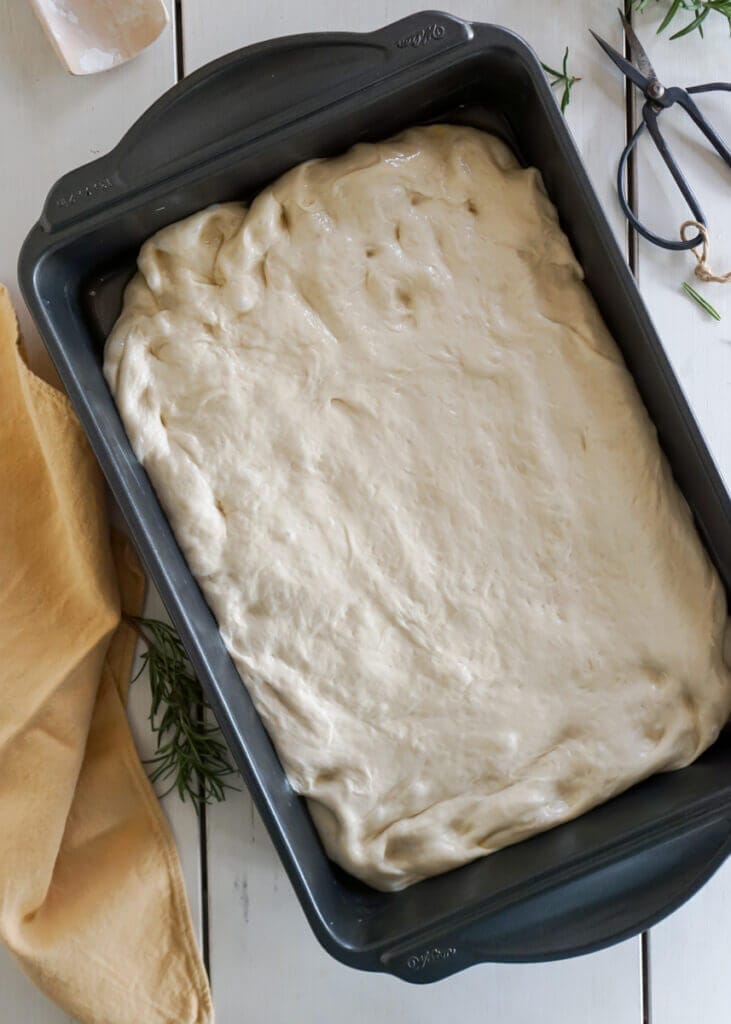

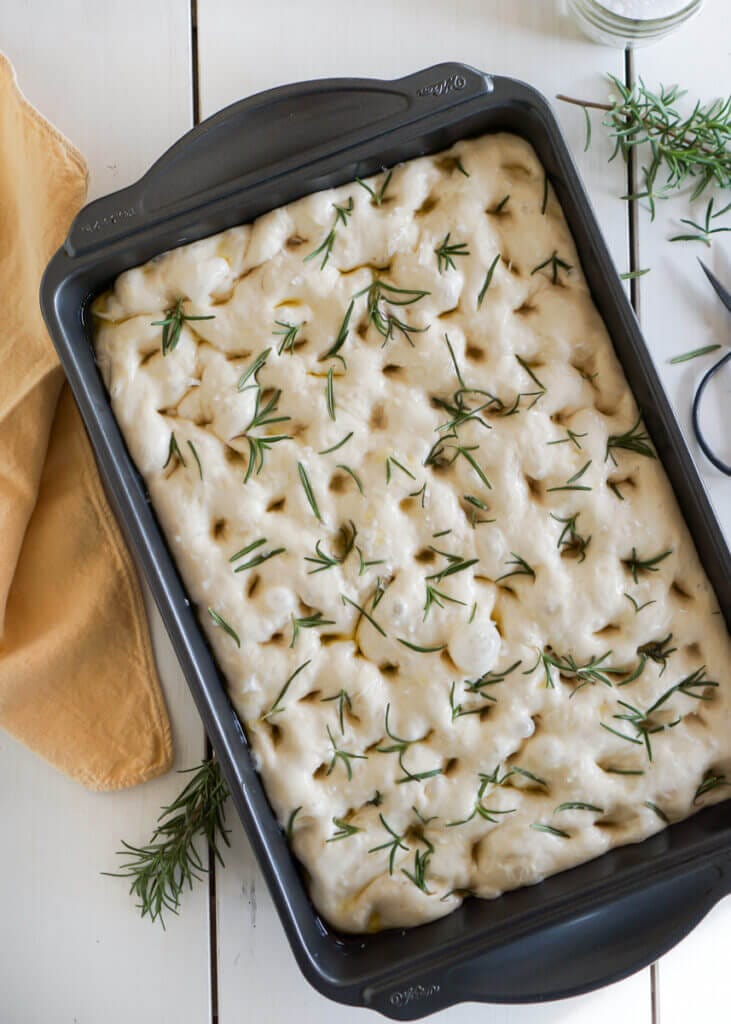
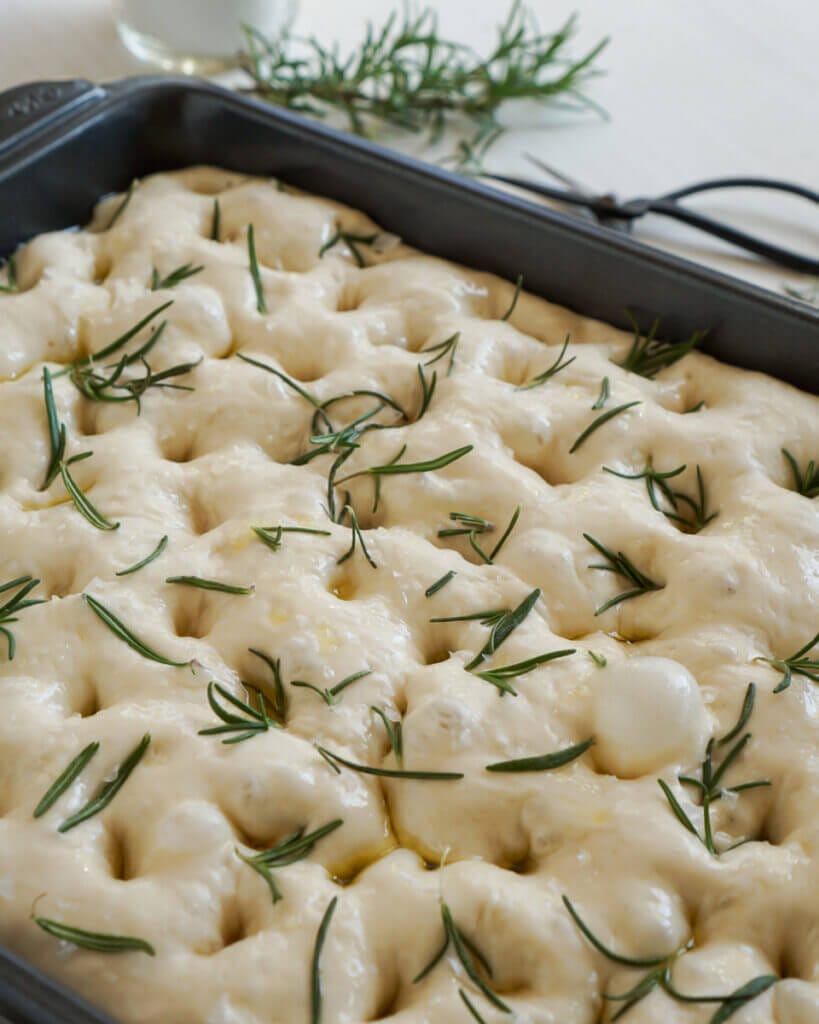
Step Four: Bake in the middle of the oven for 25-30 minutes until golden brown and crisp. Let the bread rest in the pan for 5 minutes before removing. Serve warm or at room temperature.

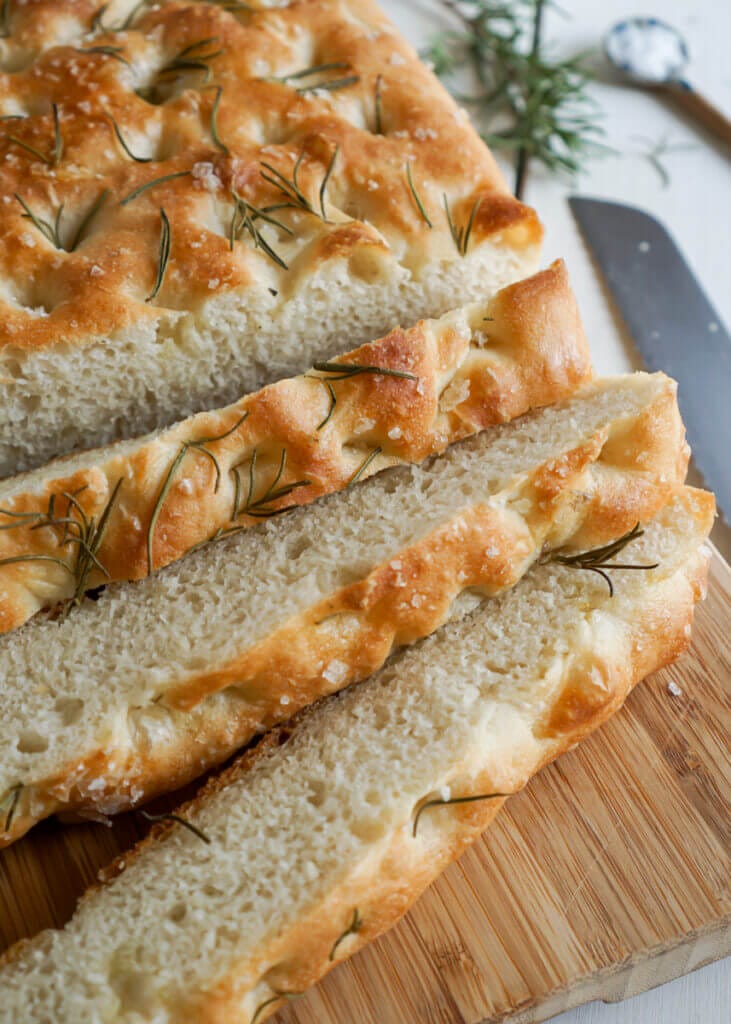
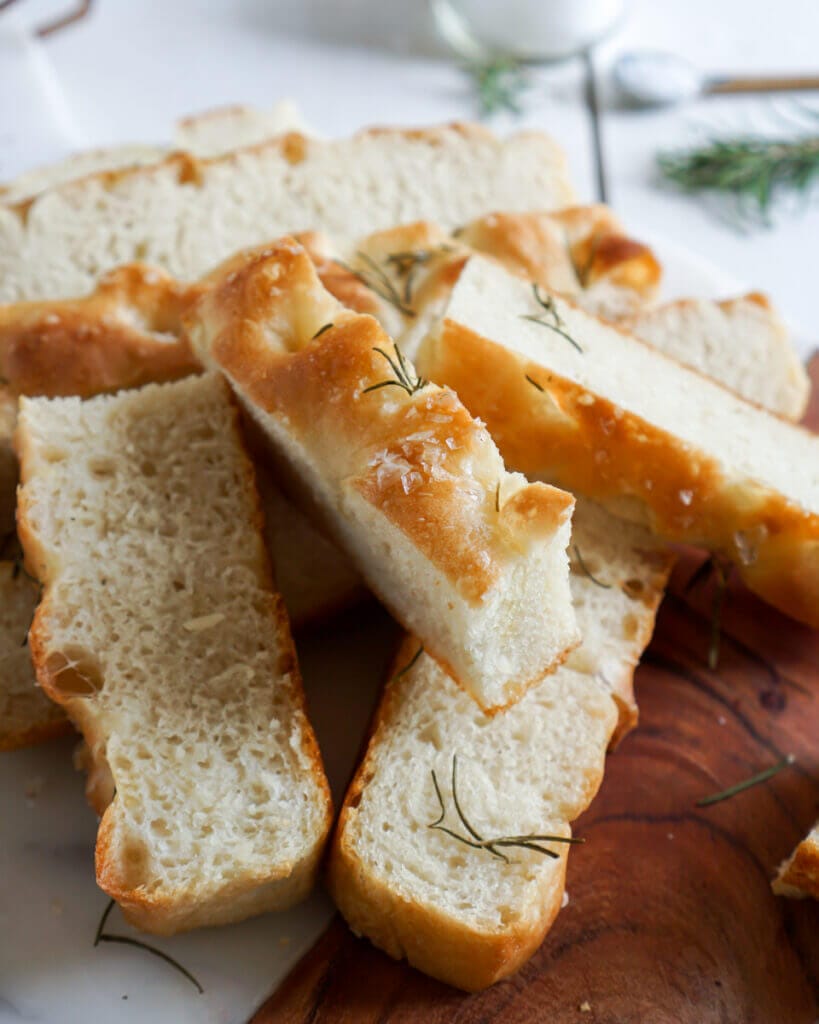
Rosemary Focaccia Bread
You’re going to love this simple traditional rosemary focaccia bread. It’s light, crispy on the outside and soft on the inside. The bread is loaded with fresh rosemary, flaky sea salt and of course olive oil. Use this bread to make Italian inspired sandwiches, or as a side dipped in balsamic vinegar. Bread comes together in less than 4 hours or can be prepped to make ahead.
- Prep Time: 3 hours
- Cook Time: 25 minutes
- Total Time: 3 hours 25 minutes
- Yield: 8–10 1x
- Category: Bread, Appetizer
- Method: Baking
- Cuisine: Italian
Ingredients
- 2 cups warm water (approx. 110˚F)
- 2 teaspoons granulated sugar
- 2 1/4 teaspoons (1 packet) active dry yeast
- 4 cups (approx.) unbleached bread flour
- 2 teaspoons salt
- 3 Tablespoons olive oil, divided
- butter for greasing
- flaky sea salt
- 2 sprigs of fresh rosemary
Instructions
- In a large bowl add warm water, yeast, and sugar together, let rest 8-10 minutes until mixture is frothy.
- When yeast is ready add 3 cups of the flour and using a fork bring the dough together until shaggy. Add another 1/2 cup of the flour and the salt. Mix to combine.
- Turn the dough out onto a floured work surface and knead the dough using the last 1/2 cup of flour as necessary (if you need more flour use 1/4 cup extra at a time). The dough should be pliable, soft and slightly sticky but not sticking to you. Knead the dough for approx. 6-8 minutes until smooth, and when poked with your finger will spring back. Roll dough into a ball.
- In a large clean bowl coat the bowl with oil, add the dough and pour 1 tablespoon of the oil all over the dough. Cover with plastic wrap, a damp towel, or a shower cap. Let dough rest in a warm draft free place until doubled in size, approx. 1-2 hours.
- Meanwhile grease a 9×12 baking pan with butter. Add 1 tablespoon of the oil to the pan and set aside.
- Once dough is doubled in size, punch dough down and place in the prepared pan. Stretch the dough out to fit the pan and press out any extra air. Cover with plastic wrap and let rest until doubled in size approx. 30-40 minutes.
- Meanwhile, preheat the oven to 425˚F.
- Once dough is doubled in size, sprinkle rosemary all over the top and the remaining 1 tablespoon of olive oil. Using your fingers (you may want to oil your fingers too) press them straight into the dough to create dimples throughout the dough, making sure to press all the way to the bottom of the pan.
- Sprinkle the top with flaky sea salt.
- Bake in the middle of the oven for 25-30 minutes until golden and crisp. Let the bread rest in the pan for 5 minutes before removing.
- Serve warm or at room temperature.
Notes
Sizes: You can make focaccia in many different sizes. Some options are:
- Two 9″ pie plates, or two 9″ square pans. Divide the dough in half and follow the recipe as directed.
- For a thinner focaccia use a baking sheet.
Make Ahead: You can also prepare your bread the day ahead and bake it fresh the following day. Simply follow the instructions to step 6 and place your prepared dough into the fridge for up to 18 hours. Then the following day pull your dough out and let it rest at room temperature for 20-30 minutes and continue to step 7.
Nutrition
- Serving Size: 1 Slice of 20
- Calories: 120
- Sugar: 0.5g
- Sodium: 292mg
- Fat: 2.6g
- Saturated Fat: 0.4
- Unsaturated Fat: 0
- Trans Fat: 0
- Carbohydrates: 20.5g
- Fiber: 0.8g
- Protein: 3.5g
- Cholesterol: 0
FAQ’s
Store focaccia bread at room temperature in a plastic bag or a container for up to 3-4 days. You can also freeze focaccia bread by placing it in an airtight freezer bag. Freeze bread for up to two months.
Rosemary Focaccia bread makes a great side on an antipasto plate filled with olives, cheeses, meats, stuffed peppers and artichokes. You can also serve focaccia bread with balsamic vinegar as a side for pasta dishes and soups.
A dense focaccia may be due to a few factors. The most common factor is not kneading the dough long enough. Kneading the dough develops the glutens, which helps to create that fluffy and chewy bread we all look for in focaccia. Another factor may be not letting the dough proof long enough. Make sure you give the dough time to double in size and to rest.
Yes, you can use instant yeast instead of active dry yeast. The ratio and technique will differ a little. The recipe calls for 2 1/4 teaspoons of active dry yeast, use 1 3/4 teaspoons instant yeast instead. Then add all ingredients together and knead as directed. There is no need to ‘bloom’ instant yeast.
This blog post has been sponsored by Bulk Barn Canada where you can find all your baking needs! All opinions are my own and I’m so happy to work with brands I love so I can continue to share these recipes with all of you! I hope you guys get to a Bulk Barn soon and try out this recipe.
You may also like:
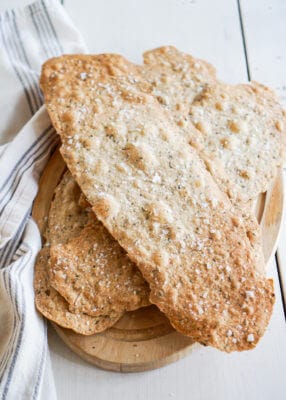




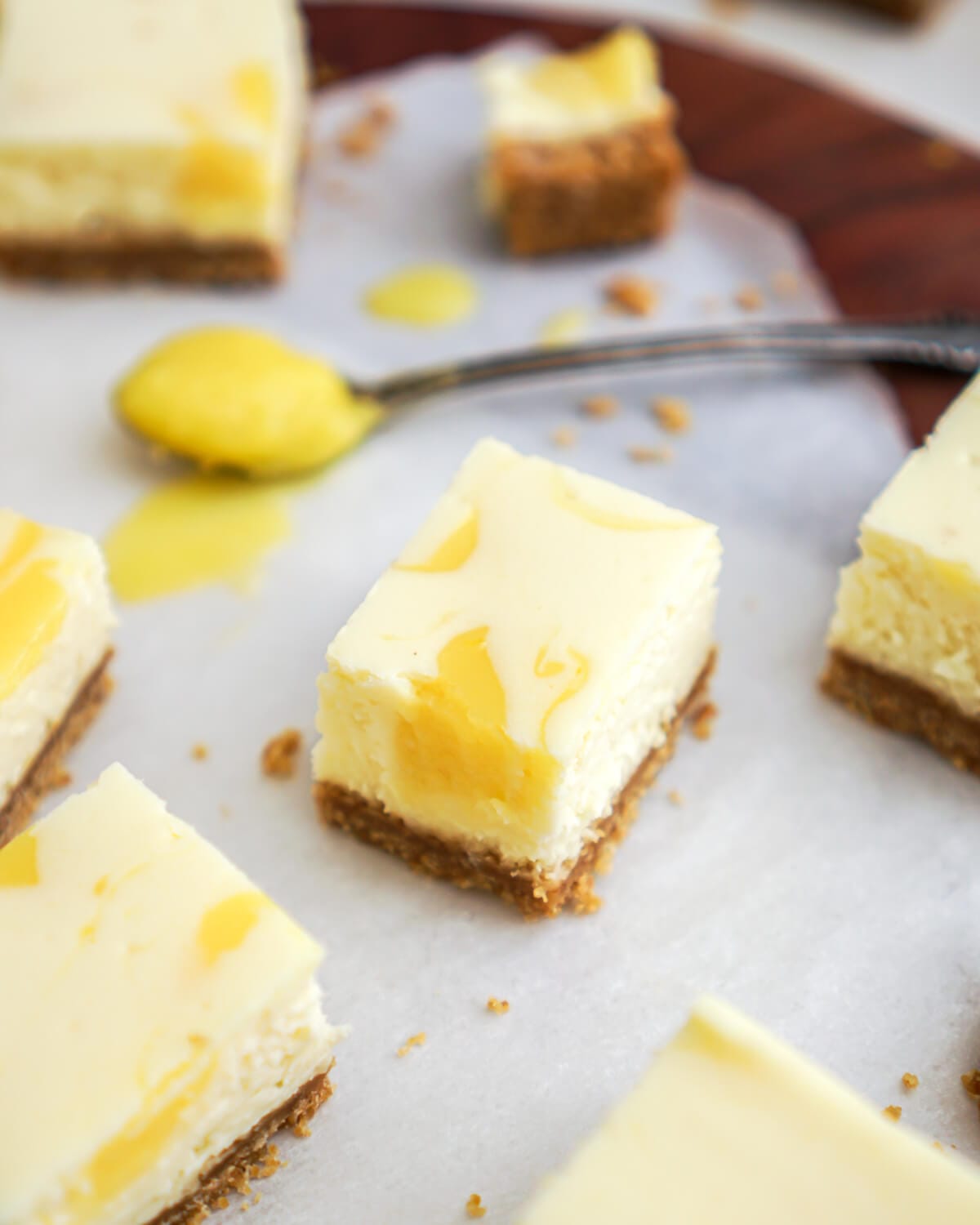


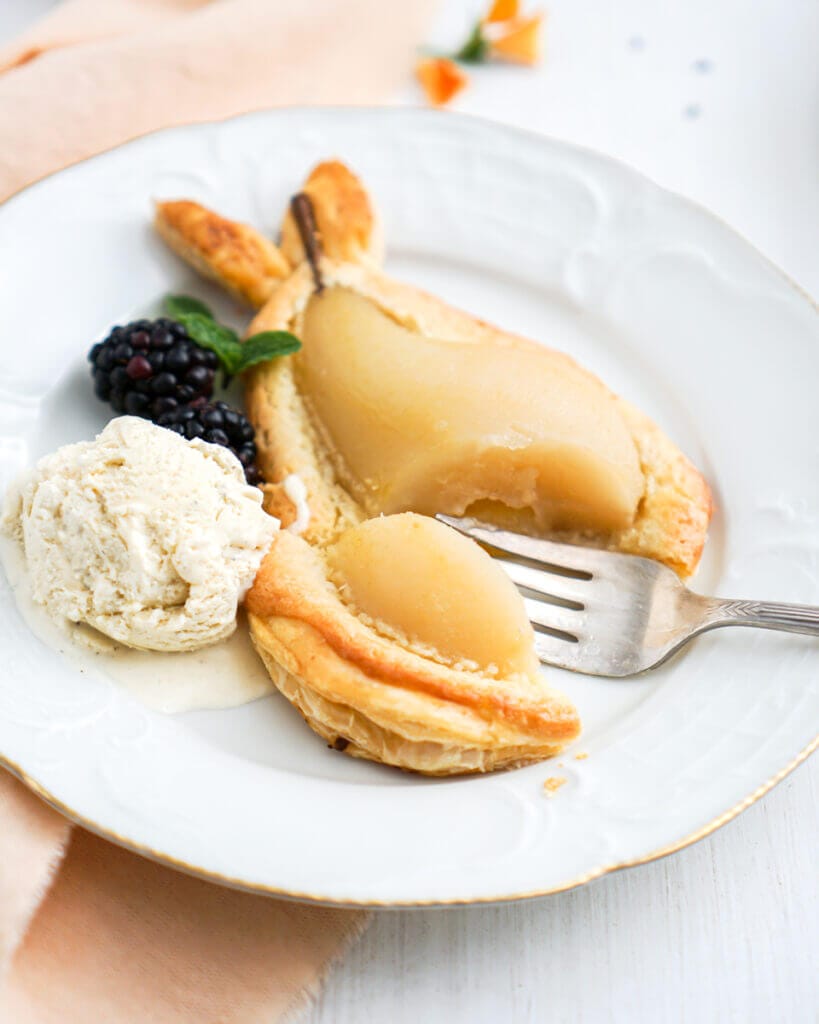









Leave a Rating and Comment!
I love hearing from you! Leave a comment with any questions or how your recipe turned out (your email address will not be published)!